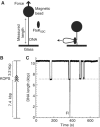KOPS: DNA motifs that control E. coli chromosome segregation by orienting the FtsK translocase
- PMID: 16211009
- PMCID: PMC1276719
- DOI: 10.1038/sj.emboj.7600835
KOPS: DNA motifs that control E. coli chromosome segregation by orienting the FtsK translocase
Abstract
Bacterial chromosomes are organized in replichores of opposite sequence polarity. This conserved feature suggests a role in chromosome dynamics. Indeed, sequence polarity controls resolution of chromosome dimers in Escherichia coli. Chromosome dimers form by homologous recombination between sister chromosomes. They are resolved by the combined action of two tyrosine recombinases, XerC and XerD, acting at a specific chromosomal site, dif, and a DNA translocase, FtsK, which is anchored at the division septum and sorts chromosomal DNA to daughter cells. Evidences suggest that DNA motifs oriented from the replication origin towards dif provide FtsK with the necessary information to faithfully distribute chromosomal DNA to either side of the septum, thereby bringing the dif sites together at the end of this process. However, the nature of the DNA motifs acting as FtsK orienting polar sequences (KOPS) was unknown. Using genetics, bioinformatics and biochemistry, we have identified a family of DNA motifs in the E. coli chromosome with KOPS activity.
Figures





References
-
- Aussel L, Barre FX, Aroyo M, Stasiak A, Stasiak AZ, Sherratt D (2002) FtsK is a DNA motor protein that activates chromosome dimer resolution by switching the catalytic state of the XerC and XerD recombinases. Cell 108: 195–205 - PubMed
-
- Bigot S, Corre J, Louarn J, Cornet F, Barre FX (2004) FtsK activities in Xer recombination, DNA mobilization and cell division involve overlapping and separate domains of the protein. Mol Microbiol 54: 876–886 - PubMed
-
- Blattner FR, Plunkett G III, Bloch CA, Perna NT, Burland V, Riley M, Collado-Vides J, Glasner JD, Rode CK, Mayhew GF, Gregor J, Davis NW, Kirkpatrick HA, Goeden MA, Rose DJ, Mau B, Shao Y (1997) The complete genome sequence of Escherichia coli K-12. Science 277: 1453–1474 - PubMed
Publication types
MeSH terms
Substances
LinkOut - more resources
Full Text Sources
Other Literature Sources
Molecular Biology Databases

